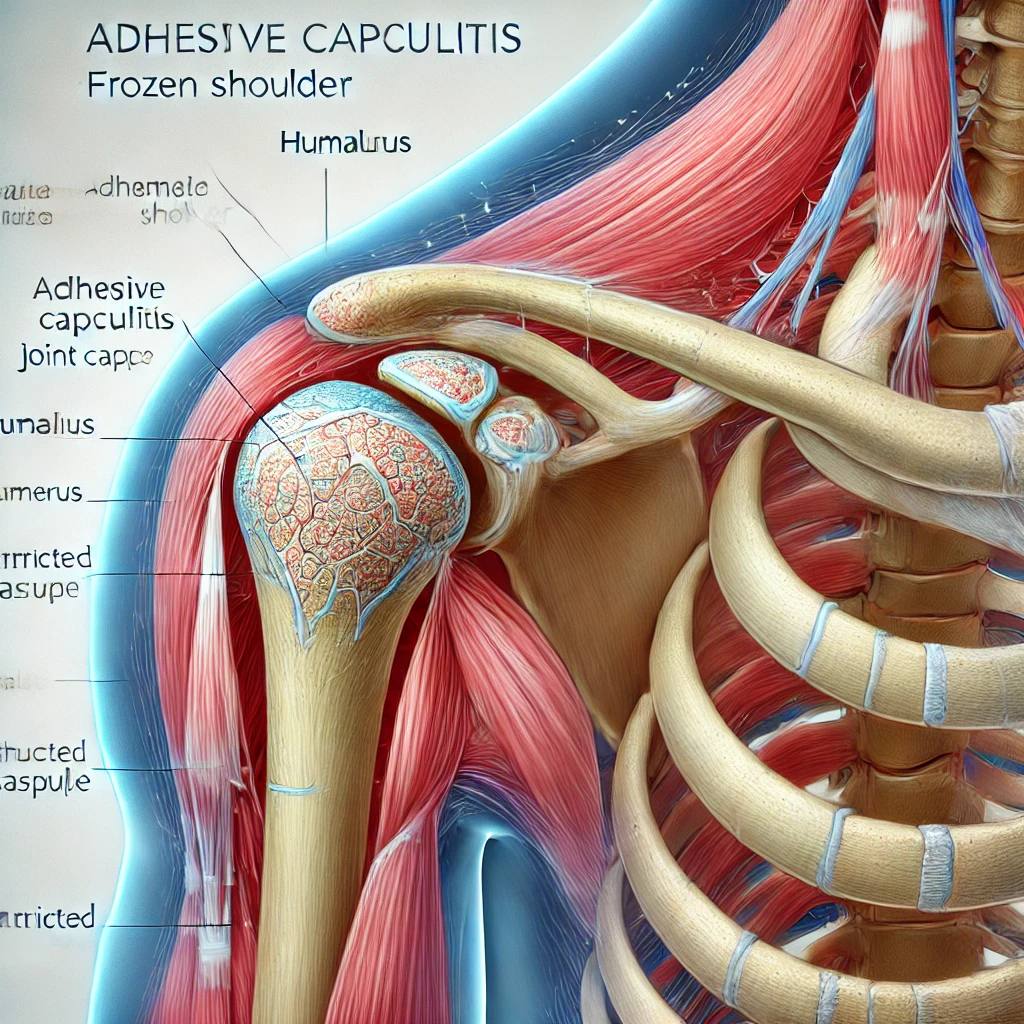
Introduction
Adhesive capsulitis, commonly referred to as frozen shoulder, is a condition characterized by pain, stiffness, and restricted movement in the shoulder joint. It typically develops gradually and can significantly impair daily activities.
Frozen shoulder often affects adults aged 40 to 60, with a higher prevalence in women and people with certain medical conditions such as diabetes or thyroid disorders.
What is Adhesive Capsulitis?
Adhesive capsulitis occurs when the capsule of connective tissue surrounding the shoulder joint thickens and tightens. This leads to the formation of adhesions, resulting in pain and restricted movement.
Symptoms of Frozen Shoulder
The primary symptoms of adhesive capsulitis include:
- Pain:
- Persistent aching or sharp pain, especially with movement.
- Stiffness:
- Difficulty moving the shoulder in any direction.
- Limited Range of Motion:
- Both active and passive movements are affected.
Stages of Adhesive Capsulitis
Frozen shoulder progresses through three distinct stages:
- Freezing Stage:
- Gradual onset of pain and stiffness.
- Movement becomes increasingly difficult.
- Lasts 6 weeks to 9 months.
- Frozen Stage:
- Pain diminishes but stiffness worsens.
- Shoulder movement is severely restricted.
- Lasts 4 to 12 months.
- Thawing Stage:
- Gradual improvement in mobility and range of motion.
- Pain continues to subside.
- Lasts 6 months to 2 years.
Causes and Risk Factors
The exact cause of adhesive capsulitis is not well understood, but it often occurs following an injury or surgery that limits shoulder movement.
Risk Factors:
- Age and Gender:
- Commonly affects people aged 40–60, particularly women.
- Diabetes:
- Up to 20% of people with diabetes develop frozen shoulder.
- Immobility:
- Shoulder immobility due to injury, surgery, or prolonged inactivity.
- Medical Conditions:
- Hypothyroidism, hyperthyroidism, Parkinson’s disease, and cardiovascular diseases.
- Previous Injury or Surgery:
- Shoulder injuries or surgeries that limit movement.
Diagnosis of Frozen Shoulder
Diagnosis involves a combination of medical history, physical examination, and imaging studies.
Steps in Diagnosis:
- Physical Exam:
- Assess range of motion and pain level.
- Imaging Tests:
- X-rays: Rule out other conditions such as arthritis.
- MRI or Ultrasound: Identify inflammation or damage to soft tissues.
Treatment for Adhesive Capsulitis
The goal of treatment is to alleviate pain and restore shoulder mobility.
Non-Surgical Treatments:
- Medications:
- Over-the-counter pain relievers like ibuprofen or acetaminophen.
- Corticosteroid injections for severe pain.
- Physical Therapy:
- Stretching and strengthening exercises to improve range of motion.
- Regular physical therapy can speed up recovery.
- Hot or Cold Therapy:
- Apply heat or ice packs to reduce pain and inflammation.
- Lifestyle Modifications:
- Avoid activities that aggravate the shoulder.
Surgical Treatments:
- Manipulation Under Anesthesia (MUA):
- The shoulder is gently manipulated while the patient is under anesthesia to improve mobility.
- Arthroscopic Surgery:
- Minimally invasive surgery to release tight tissue or remove adhesions.
Complications
Without proper treatment, frozen shoulder can lead to:
- Chronic pain and stiffness.
- Permanent loss of shoulder mobility.
- Difficulty performing daily activities.
Prevention of Frozen Shoulder
While not all cases of adhesive capsulitis can be prevented, the following steps can reduce the risk:
- Maintain Mobility:
- Perform regular shoulder exercises, especially after an injury or surgery.
- Early Intervention:
- Seek medical attention if you experience shoulder pain or stiffness.
- Manage Underlying Conditions:
- Properly control diabetes or thyroid disorders.
Frequently Asked Questions (FAQ)
Q: How long does frozen shoulder last?
A: Frozen shoulder can last between 1 to 3 years, depending on the individual and treatment.
Q: Can frozen shoulder resolve on its own?
A: In some cases, it may resolve without treatment, but this process can take years. Early intervention is recommended to speed up recovery.
Q: Is frozen shoulder linked to stress?
A: While stress is not a direct cause, it may exacerbate symptoms due to muscle tension and reduced pain tolerance.
Q: Can physical therapy cure frozen shoulder?
A: Physical therapy is highly effective in restoring mobility and reducing symptoms, but results vary by individual.
Takeaway
Adhesive capsulitis, or frozen shoulder, is a painful condition that restricts shoulder movement. Early diagnosis and a combination of treatments such as physical therapy, medication, and lifestyle changes can significantly improve symptoms.
If you experience persistent shoulder pain or stiffness, consult a healthcare provider for an accurate diagnosis and personalized treatment plan.
Leave a Reply